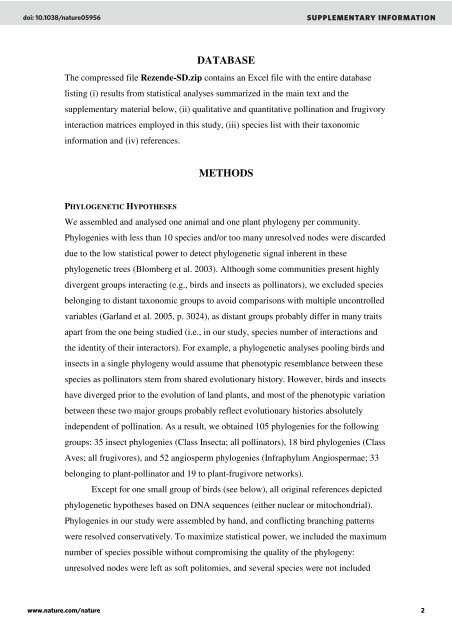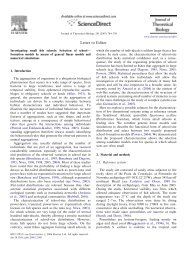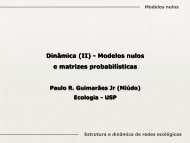SUPPLEMENTARY INFORMATION - Paulo R. Guimarães Jr.
SUPPLEMENTARY INFORMATION - Paulo R. Guimarães Jr.
SUPPLEMENTARY INFORMATION - Paulo R. Guimarães Jr.
You also want an ePaper? Increase the reach of your titles
YUMPU automatically turns print PDFs into web optimized ePapers that Google loves.
5956 <br />
DATABASE<br />
The compressed file Rezende-SD.zip contains an Excel file with the entire database<br />
listing (i) results from statistical analyses summarized in the main text and the<br />
supplementary material below, (ii) qualitative and quantitative pollination and frugivory<br />
interaction matrices employed in this study, (iii) species list with their taxonomic<br />
information and (iv) references.<br />
PHYLOGENETIC HYPOTHESES<br />
METHODS<br />
We assembled and analysed one animal and one plant phylogeny per community.<br />
Phylogenies with less than 10 species and/or too many unresolved nodes were discarded<br />
due to the low statistical power to detect phylogenetic signal inherent in these<br />
phylogenetic trees (Blomberg et al. 2003). Although some communities present highly<br />
divergent groups interacting (e.g., birds and insects as pollinators), we excluded species<br />
belonging to distant taxonomic groups to avoid comparisons with multiple uncontrolled<br />
variables (Garland et al. 2005, p. 3024), as distant groups probably differ in many traits<br />
apart from the one being studied (i.e., in our study, species number of interactions and<br />
the identity of their interactors). For example, a phylogenetic analyses pooling birds and<br />
insects in a single phylogeny would assume that phenotypic resemblance between these<br />
species as pollinators stem from shared evolutionary history. However, birds and insects<br />
have diverged prior to the evolution of land plants, and most of the phenotypic variation<br />
between these two major groups probably reflect evolutionary histories absolutely<br />
independent of pollination. As a result, we obtained 105 phylogenies for the following<br />
groups: 35 insect phylogenies (Class Insecta; all pollinators), 18 bird phylogenies (Class<br />
Aves; all frugivores), and 52 angiosperm phylogenies (Infraphylum Angiospermae; 33<br />
belonging to plant-pollinator and 19 to plant-frugivore networks).<br />
Except for one small group of birds (see below), all original references depicted<br />
phylogenetic hypotheses based on DNA sequences (either nuclear or mitochondrial).<br />
Phylogenies in our study were assembled by hand, and conflicting branching patterns<br />
were resolved conservatively. To maximize statistical power, we included the maximum<br />
number of species possible without compromising the quality of the phylogeny:<br />
unresolved nodes were left as soft politomies, and several species were not included





